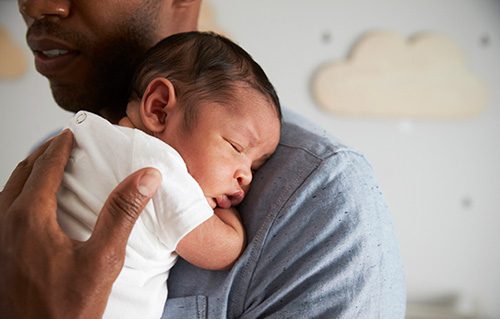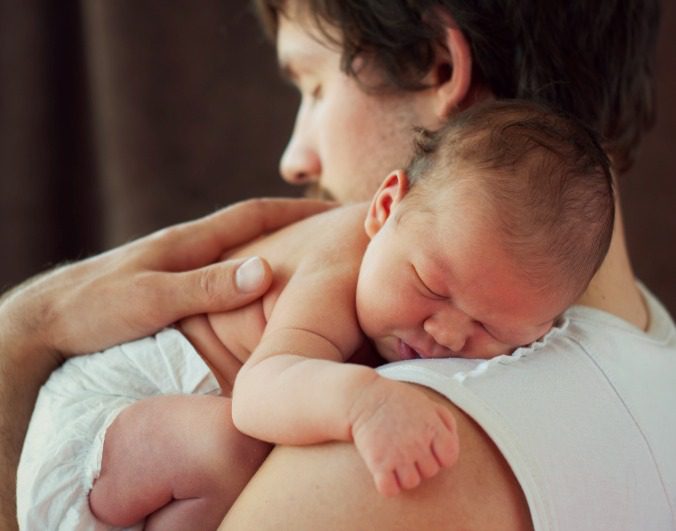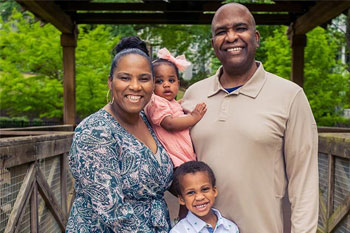
Many new adoptive dads are surprised at the adjustment to having a newborn baby. The initial weeks of caring for a newborn can be tough, but having an idea of what to anticipate can help ease the process.
You might find it difficult to learn the infant care skills needed to be a parent, so getting all the info on how to be a dad before you bring your baby home is a good idea. Think of this as your chance to get ahead of the game! Before you bring your baby home through adoption, learn:
1. What to pack in a diaper bag
A diaper bag will be your best friend during those early months, one that you’ll always want by your side. Being well-prepared for whatever life throws your way, from sudden hunger pangs to unexpected diaper disasters, is crucial for every parent.
A well-packed diaper bag, slung over your shoulder and easily attached to the stroller, can be a lifesaver in those messy situations. Important items to have in your baby’s diaper bag include:
- Bottles
- Formula
- A pacifier
- Diapers
- Wipes
- Ointment
- At least one change of clothing for baby
- A burp rag
- Hand sanitizer
- Changing pad
- A wet bag for soiled diapers
2. How to feed your newborn
A newborn’s stomach is very tiny, so the amount they need at each feeding is pretty small. When they’re born, a baby’s tummy is no bigger than a toy marble (about one to two teaspoons)! By ten days old, your baby’s stomach is about the size of a ping pong ball (about two ounces).
Consider placing a rocking chair or glider in your baby’s room to make feeding and burping your newborn more comfortable. Having a comfortable chair where you can relax during those middle-of-the-night feedings can make a big difference.
Typically, bottle-fed babies take anywhere from 20 to 40 minutes to feed, while breastfeeding may take a similar amount of time. Newborns often fall asleep while feeding, so you might find yourself needing to wake them up to finish eating, which can extend the length of feedings to an hour or longer. While feeding can be a sweet experience, it can feel never-ending when you’re exhausted.
3. How to install the car seat
Practice installing your baby’s car seat as soon as you’ve entered an adoption match with a birth mother. Figuring this out ahead of time will mean one less thing to worry about when you travel for the adoption.
If you find the instructions confusing, try looking for video tutorials on YouTube. It would also help to visit your local Child Car Seat Inspection Station. You can locate one near you by visiting the National Child Passenger Safety Certification website. I recommend purchasing two bases for your infant car seat, one for each car.
4. The basics of infant sleep
In the first few weeks after birth, your baby will sleep a lot, waking only when they need to be fed. Most newborns wake every couple of hours to feed, as babies have shorter sleep cycles than adults. Plus since their tiny stomachs don’t hold enough breast milk or formula to keep them full for long, they wake often to eat — no matter what time of day or night it is.
By three months old, most babies settle into a longer awake and sleep pattern. However, until then, be prepared to get up a few times a night to feed your little one.
The American Academy of Pediatrics recommends that newborn babies be placed on their backs to sleep in their own sleep space, which could be a bassinet, crib, or pack-and-play. You can keep your baby’s sleep area in the same room as you for the first six months to a year, but you should not bed-share. Having your baby sleep in the same room as you will make the frequent night feedings that they need so much easier!
If you have received a used crib for your baby, you should ensure it is safe. One way to do this is by checking the U.S. Consumer Product Safety Commission website to verify if the crib has been recalled.
5. How to swaddle your baby
Swaddling mimics the coziness of being in the womb, so it’ll calm your baby and help them sleep. At the hospital, your baby’s nurse will probably show you how to swaddle them in a blanket. Basically, you lay a blanket down and tuck the edges around your baby so that it becomes like a little “papoose.”
Many parents prefer using a dedicated swaddle blanket like this one. These specially designed blankets and sacks come with fasteners, snaps, and/or zippers, making the swaddling process much easier, especially when sleep-deprived.
6. How to change your baby’s diaper
Open up a new, clean diaper and put it under your baby. The part with tabs on either side should go under his back. Undo the tabs on his dirty diaper, and pull down the front half. Lift your baby’s bottom off the table and fold the dirty diaper under your baby, with the clean side up.
With baby wipes, cloth, or gauze, clean your baby’s front, remembering always to wipe from front to back. Pull the front half of the new diaper up to your baby’s belly. Fold down the diaper in front to avoid covering your baby’s umbilical cord stump until it falls off. They also sell special disposable diapers with a notch cut out for the stump. Finish the diaper change by fastening your baby’s diaper on both sides with the tabs.
Practice Patience
Babies have a limited way of communicating because they can’t talk. So, how they’ll try to communicate with you is by crying, screaming, smiling, whining, and cooing. Sometimes you won’t understand what they’re trying to tell you right away. That’s normal…be calm and hang in there.
Finally, try to catch some zzz’s when your baby sleeps. You’ll be marveling over the miracle of this little being coming into your lives through adoption, so it’ll be hard not to want to watch their angelic face while sleeping. But you need sleep, too; try napping when your baby is napping.
Expecting 101: You’re Adopting
Have you heard about the special course for hopeful adoptive parents, “Expecting 101: You’re Adopting”? This course provides valuable insights into bonding with your baby, newborn feeding, understanding your baby’s cries, and even infant CPR, tailored specifically for future adoptive parents.
It was developed by Valerie Trumbower, a Certified Postpartum Doula with extensive experience in newborn care and supporting new parents. Her course equips adopting parents with the essential knowledge to navigate the early days with their soon-to-be adopted baby. Valerie offers guidance on bonding strategies, necessary baby gear upon meeting the baby, and essential purchases for the initial month until the adoption process is finalized.
Sign up for Expecting 101…You’re Adopting here and use coupon code LIFETIME to get 20% off your course fee!
Lifetime Adoption
Lifetime Adoption wishes you and yours a happy Father’s Day weekend! We hope you are surrounded by loved ones on this special day. No matter where you are in the adoption process, we want to thank you for choosing adoption. We hope you all have the chance to enjoy some quality time and all the little things with the ones you love this weekend.
When you bring your adopted newborn home, you’ll experience a lot of adjustments. Some may be expected, but others not so much. It’s important to remember that you’re in a transitional stage right now, and despite how much you prepare, there will always be surprises.
Be kind to yourself during this significant change. Make sure to get enough rest, eat well, and find time for some exercise. Becoming a parent is a big deal, so give yourself the space you need to adjust.
Editor’s Note: This article was originally published on September 8, 2016, and has since been updated.
Founder of Lifetime Adoption, adoptive mom, adoption expert, and Certified Open Adoption Practitioner (C.O.A.P).
Since 1986, adoption expert Mardie Caldwell has been dedicated to bringing couples and birth parents together in order to fulfill their dreams.
“Many years ago, I was also searching for a child to adopt. We didn’t know where or how to get started. Through research, determination, and a prayer, our dream of a family became reality. I started with a plan, a notebook, assistance from a caring adoption consultant and a lot of hard work; this was my family I was building. We had a few heartaches along the way, but the pain of not having children was worse!
Within weeks we had three different birth mothers choose us. We were overwhelmed and delighted. Many unsettling events would take place before our adoption would be finalized, many months later. Little did I know that God was training and aligning me for the adoption work I now do today. It is my goal to share with our families the methods and plans which succeed and do not succeed. I believe adoption should be affordable and can be a wonderful “pregnancy” for the adoptive couple.
I have also been on both sides of infertility with the loss of seven pregnancies and then conceiving by new technology, giving birth to a healthy daughter. I have experienced first-hand the emotional pain of infertility and believe my experience allows me to serve your needs better.
It is my hope that for you, the prospective parents, your desire for a child will be fulfilled soon.”






0 Comments